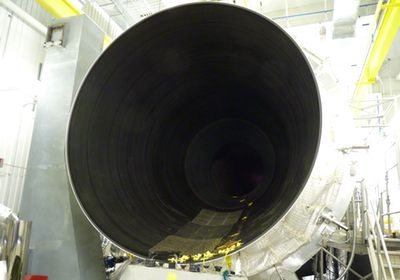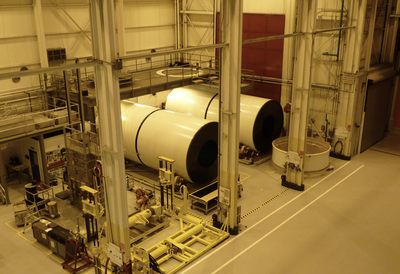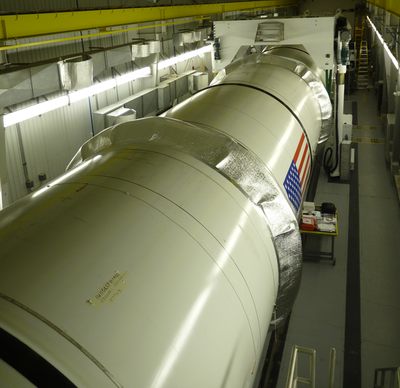DM-2 and the future of SRBsby Jeff Foust
|
| How do you get a large rocket motor chilled to within a few degrees of freezing in the middle of the summer? The answer: air conditioning, and lots of it. |
The biggest demonstration of that ongoing work is scheduled to take place Tuesday morning in Utah, when NASA and ATK will conduct a test of a five-segment rocket motor like the one that would power the first stage of Constellation’s Ares 1 launch vehicle. During the two-minute test firing, the Development Motor 2 (DM-2) solid rocket motor will generate up to 16 million newtons (3.6 million pounds-force) of thrust while remaining firmly anchored to its horizontal test stand at ATK’s facilities in Promontory, Utah.
As the name suggests, DM-2 is the second test of the five-segment solid rocket motor developed for Constellation, building upon the heritage of the four-segment motors used in the shuttle program. The DM-1 test last fall was the first test of the new motor (see “Taming the fire: the Ares 1 first stage development test”, The Space Review, September 14, 2010), and NASA officials were pleased with the results. “All performance measurements were within specified limits and 46 total objectives, covering each significant design feature of the motor, were met,” Andy Schorr, first stage, five-segment motor lead for Ares Projects at NASA's Marshall Space Flight Center, said in a statement.
The DM-2 test is designed to expand the envelope of operating conditions for the five-segment motor by cooling the motor to about 40°F (4°C) to test its redesigned joints. The joints were modified after the Challenger accident in 1986, including the addition of joint heaters to keep the O-rings flexible at cold temperatures. Since then, though, engineers have developed O-rings with a new material that is far more resilient at colder temperatures than the old materials, to the point where the joint heaters are no longer necessary. A major part of the DM-2 test will be to confirm the performance of the joints at these colder temperatures.
But how do you get a large rocket motor chilled to within a few degrees of freezing in the middle of the summer? The answer, revealed on a recent visit to the ATK test site: air conditioning, and lots of it. Several large air conditioning units sit outside the building that surrounds the motor, pumping in air at temperatures below 20°F (–7°C). Even in the relatively dry Utah conditions some of the pipes carrying the chilled air into the building have built up a thin layer of ice.
Inside the building the temperature is cold enough that some workers don winter coats and hats to keep themselves warm while continuing preparations for the test despite the summer heat outside the building. The chilling process started in early July and, within a few weeks, the motor’s temperature got down into the desired temperature. With a few exceptions, the motor will remain in its air-conditioned enclosure until a few hours before the scheduled 9:27 am MDT (11:27 am EDT) firing, when the building will be rolled back for the final countdown to ignition.
Once inside, one can be excused for not immediately recognizing the motor for what it is. Placed horizontally and surrounded by equipment, including that needed for the wide array of sensors used for the test (the motor is the most heavily instrumented one ever, with more than 760 sensors measuring virtually every aspect of the motor during its firing), you might confuse it with a portion of a particle accelerator in some physics lab.
That is, until you walk down to the nozzle. The large black nozzle makes it instantly clear what the purpose of this object is; the size of it helps calibrate its potential as well. Standing on a stepladder with a flashlight, you can look all the way down (up?) the motor’s interior to the igniter assembly at the far end. Regardless of what one thinks about Constellation or Ares, it’s hard not to be impressed with the size and performance of the five-segment motor.
 The business end of DM-2. (credit: J. Foust) |
However, the decisions about the future direction of NASA’s exploration programs won’t be made on the basis of how powerful and spectacular a particular motor test is. (Although a spectacular failure, however unlikely, would have a potentially much bigger effect than a successful test.) Many other factors beyond the technology being demonstrated—costs and budgets, jobs, and commercialization—as well as willingness of key parties to compromise and strike deals, will play a much bigger role in the outcome of the debate.
| Only time will tell whether DM-2 is the next step in the continuing development of a next-generation crew or heavy-lift vehicle of some design, or a swan song for Constellation. |
That puts the five-segment motor, and the people working on it, in something of a state of limbo now. The motor was planned for use in Ares 1, a vehicle that would be cancelled under the administration’s plan for NASA. The agency now makes no mention of the Ares 1 in announcements about the upcoming DM-2 firing. A press release last month by NASA Marshall about DM-2 explains that the test “is designed to advance the understanding, safety, technology and capability of solid rocket motors.” A more recent media advisory about the test from NASA Headquarters acknowledges that the motor was developed as part of Constellation but adds that it “is highly transferable to future heavy-lift vehicle designs.”
Congress has other, differing visions of the future of a five-segment motor. The House version of a NASA authorization bill prescribes the development of a crew launch vehicle that looks very similar to Ares 1, calling for a vehicle that makes “maximum practicable use of the design, development, and test work” done to date and projected levels of safety no less than planned for Ares 1/Orion. The Senate version, though, calls for immediate development of a larger heavy-lift vehicle capable of placing at least 70 tons into low Earth orbit. In the report accompanying the bill, the Senate sketches out in some detail what it thinks such a vehicle should look like: “a large center tank structure with attached multiple liquid propulsion engines and, at a minimum, two solid rocket motors composed of at least four segments being attached to the tank structure to form the core, initial stage of the propulsion vehicle.”
 Solid rocket motor cases being prepared for use on a future five-segment test at ATK’s Promontory, Utah, facility. (credit: J. Foust) |
With the Senate version apparently acceptable to NASA—deputy administrator Lori Garver told the Huntsville Times earlier this month that the agency is ready to start “robust” work on a heavy-lift vehicle in 2011, earlier than the agency previously planned—that would seem to provide new life for the solid rocket motors built by ATK, be it in the shuttle’s four-segment version or the five-segment version being tested. However, report language is not binding on NASA, which could instead comply with the legislation calling for heavy-lift development in other ways.
So that leaves ATK wondering what will come next for the company after Tuesday’s DM-2 test. On a visit to the Promontory facility on a Friday morning earlier this month the buildings where the motors are assembled were relatively quiet. Part of that was due to summer work schedules, but another part was due to a lull in work: all the shuttle solid rocket motors have been built, and work was not scheduled to start in earnest until next month on the next five-segment test motor, DM-3. (Depending on the outcome of the DM-2 test and the current Washington debate, some have hinted that DM-3 could be converted from another static ground test to a suborbital test flight.)
Whatever the outcome of that debate, though, the focus now for NASA and ATK is a successful DM-2 firing Tuesday morning. Only time will tell whether it is the next step in the continuing development of a next-generation crew or heavy-lift vehicle of some design, or a swan song for Constellation as NASA and the nation go in another direction for the future of human spaceflight and space exploration.
